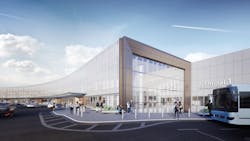In recent years, architects and designers, like myself, have been vocal advocates for integrating passenger experience into airport design. Visit any new or recently renovated terminal and one will find a bevy of projects that include relatively simple, yet effective, passenger-focused features: more local shops and restaurants, local artwork and exhibits, more spots for passengers to plug-in. It’s not only great for the passenger but for the airports bottom lines as adding amenities and choices are great for revenue.
So, what’s next?
At HKS, as we think about the future, we see a departure from passenger experience to a more intense focus on passenger lifestyle. People are making choices driven by their physical, emotional and mental well-being; therefore, we must focus on how we can evolve the environment beyond hospitality-oriented retail amenities and concessions to designing airports that are an extension of our passengers’ everyday lives and routines.
Travelers are diverse. But regardless of their backgrounds, when they arrive at the airport, their outside interests and commitments arrive with them. And unlike oversize baggage, those interests aren't checked before arriving at the gate. A working person on a business trip still needs a space that is conducive to working. Someone who is conscious about the amount of exercise or standing for hours before boarding a flight, will want to get in as many steps in as possible. And kids, well, are still kids wherever you are with them. When we start thinking about incorporating a lifestyle, it becomes clear that we must create environments that reflect a multitude of interests and routines.
What does this look like?
Driven by the need for early arrival or for those that are transferring onto other flights, coupled with the uncertainty of on time travel, passengers often encounter prolonged wait times. As we work to develop more efficient security processes, travelers will have increased time to enjoy activities they might choose to do on a normal day out: comfortable on-demand movie lounges or small-scale cinemas, live music or theater performances, participatory learning installations and more.
Business travelers are not as productive when they are forced to take the word “laptop” literally. They aren't alone. Most people try to avoid cramped, crowded spaces. We don’t intentionally seek out and stand in long lines. We don’t sit shoulder to shoulder on rows of uncomfortably tight chairs virtually anywhere else we frequent.
Designers can look forward to taking advantage of having more airside space to create efficient, private and quiet areas to work set apart from the crowded, noisy gate lounges and airline clubs. Investing in areas for people to relax, play and exercise – such as children’s playgrounds, gyms, sleeping pods, mini-golf, outdoor gardens and more – will pay dividends in both revenue and user satisfaction.
Incorporating passenger lifestyle elements into airports already is happening. One of our current projects, in partnership with Woods Bagot, is San Francisco International Airport (SFO) Terminal 1 Boarding Area B, scheduled for completion in 2023. When finished, it will include: museum exhibit space, 17 Site-specific commissioned Artworks, a children’s play area, a pet relief room and more. While there are examples around the world in newer and remodeled airports where you can find certain elements of these passenger lifestyle accommodations, it rarely happens as the core driver of airport design and architecture like it does for SFO’s vision.
SFO Terminal 1 Boarding Area B will feature an abundance of natural light throughout with floor-to-ceiling windows, creating both the reality and impression of more space and a connection to the world outside. The high-ceilinged centralized hall is visible from above as soon as the passenger goes through security. From that vantage point, passengers can see restaurants and retail and other amenities surrounding the hall. They can identify those quiet work areas that have been set apart, the children’s play spaces and a host of features more in keeping with a healthy lifestyle. Whether passengers are drawn to seating clusters that offer a reasonable sense of private space, or to comfortable chairs looking directly out onto the tarmac and the planes that are arriving and departing, they will have the opportunity to experience a sense of respite and relaxation now atypical of the airport environment.
As technology advances and most passengers arrive with boarding passes already in hand, we no longer need the cavernous check-in areas that were designed for long queues of passengers who needed to do at the airport what they now can do for themselves. For those who still need to print a boarding pass, self-service kiosks are plentiful. While there will always be passengers with more complex needs, the space we need to devote for those purposes will be fractionally smaller than exists today. Technological advances have put passengers more in charge, so this is space that now can be reclaimed and reallocated within the existing airport footprint to make the airside experience more accommodating to passenger lifestyles.
Airlines, especially as they have consolidated and become more efficient themselves, are demanding bigger and better terminals with more services and amenities to build an even greater sense of passenger loyalty, creating both airlines and airports “of choice.” In addition, cities and regions continue to put emphasis on their airports as economic engines as well as points of civic pride. They want attractive spaces that are efficient and functional, knowing how important air travel is to economic development, quality of life and the ability to compete with other parts of the country for new and expanding businesses.
We believe that passenger lifestyle must be central to our future thinking as we move forward in remodeling the airports of today or building the airport terminal of tomorrow. In so many areas of our work at HKS, we have found that when clients incorporate design partners into the thinking and planning and debate from the very outset of a project, it leads to collaboration, teamwork and and trust – and true breakthroughs happen. Making passenger lifestyle designs work within a limited footprint will take close and early coordination and collaboration between airport planners and architects. Leveraging outside expertise, working alongside staff and stakeholders, creates a practical and efficient creative synergy that allows major projects to meet the needs of airlines and airports – and, most importantly, the passengers that keep them financially sound.
We are fully mindful that airports and airlines both want and need these passenger spaces to generate revenue. That is precisely why many are investing in minor and major facility improvements. There has been an unprecedented increase in air travel since we emerged from the Great Recession, and that is expected to continue. Providing more opportunities for the flying public to interact with various amenities is essential to creating healthy airport balance sheets as well as a healthy traveler.
Pat brings to HKS a tremendous wealth of aviation industry knowledge. He’s an avid globetrotter and has worked with some of the world’s most successful airports and airlines – from American Airlines to Emirates Airlines to JetBlue and from LAX to Heathrow to Dubai. He also led the team that designed Terminal A at Boston’s Logan International Airport – the first-ever, LEED-certified airport terminal building. Pat is celebrated industrywide for his expertise in the planning, design and delivery of highly complex projects, but he’s most passionate about ushering in a new and more holistic way of thinking about aviation and transportation. He believes airports should be much more than just a place where planes transport passengers – they can be a reflection of their city, provide world-class amenities and offer personalized concierge services.






